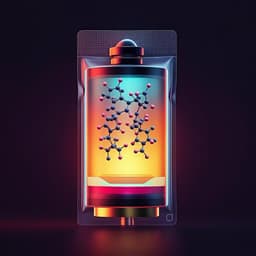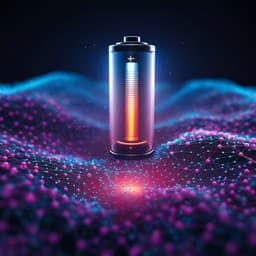
Chemistry
Non-flammable solvent-free liquid polymer electrolyte for lithium metal batteries
G. Zhu, Q. Zhang, et al.
Discover a groundbreaking advancement in lithium metal batteries! This research introduces a novel non-flammable liquid polymer electrolyte (LPE) that enhances ionic conductivity, suppresses lithium dendrite growth, and ensures stable cycling over a wide temperature range. Conducted by prominent researchers Guo-Rui Zhu, Qin Zhang, Qing-Song Liu, Qi-Yao Bai, Yi-Zhou Quan, You Gao, Gang Wu, and Yu-Zhong Wang at Sichuan University, this innovative design promises improved safety and performance.
~3 min • Beginner • English
Introduction
The study addresses the need for lithium batteries that operate safely and efficiently over a wide temperature range, especially at high temperatures (>60 °C), where conventional organic liquid electrolytes suffer from volatility, flammability, swelling/leakage, and aggravated lithium dendrite growth. Solid ceramic electrolytes, while thermotolerant, face interface and stability issues; solid polymer electrolytes (SPEs) offer flexibility and manufacturability but typically have low room-temperature ionic conductivity and poor interfacial contact, leading to voids and dendrites. Gel/quasi-solid polymer electrolytes improve interfacial wetting by adding small-molecule plasticizers/solvents, but reintroduce flammability and thermal runaway risks. The research question is whether a solvent-free, nonflammable, liquid polymer electrolyte (LPE)—a room-temperature liquid brush-like polyphosphazene serving as the sole solvent for lithium salts—can combine the interfacial wetting and conductivity advantages of liquids with the safety and stability of polymers to enable high-temperature, dendrite-free, long-life lithium metal batteries.
Literature Review
- Conventional liquid electrolytes (ethers/carbonates) provide high ionic conductivity and wetting but are volatile and flammable, causing safety hazards and thermal runaway at elevated temperatures.
- Solid ceramic electrolytes are fireproof and thermally stable but have low oxidation stability, environmental sensitivity (H₂O/O₂), and poor electrode–electrolyte interfacial compatibility.
- SPEs based on polymers such as PEO, PPC, and PDOL alleviate some issues but suffer from low room-temperature ionic conductivity and interfacial contact problems; Li+ transport relies on polymer segmental motion and coordination with polar groups.
- Gel/quasi-solid polymer electrolytes enhance RT conductivity and wetting via small-molecule solvents/plasticizers but compromise high-temperature safety.
- Brush/comb polymers can suppress entanglement and reduce glass transition temperature, potentially improving ion transport and interfacial wetting while maintaining polymeric safety characteristics. Prior studies indicate bottlebrush/brush melts can be supersoft and solvent-free.
- Flame-retardant polymer systems (e.g., phosphazenes) can impart nonflammability; prior work has used flame-retardant GPEs but typically still relies on solvent components.
This work builds on these insights by designing a solvent-free, nonflammable brush-like polyphosphazene host with ether side chains for an LPE to address conductivity, interfacial stability, dendrite suppression, and safety at high temperature.
Methodology
- Materials and synthesis:
- Poly[bis-(methoxytriethoxy)phosphazene] (PPZ) synthesized via melt bulk polymerization of phosphonitrilic chloride trimer (HCCP) at 260 °C (36 h) to form PDCP, purification, then nucleophilic substitution with sodium alkoxide (from TGME + NaH) in THF (12 h at 0 °C, then 12 h at 60 °C), dialysis, and vacuum drying (80 °C, 48 h). Characterized by 31P and 1H NMR; GPC (Mn ≈ 136.4 kDa, Mw ≈ 538.5 kDa, PDI ≈ 3.9).
- LPE formation by dissolving LiTFSI in PPZ at O:Li molar ratios of 8:1, 16:1, 24:1, 40:1 (denoted PPZ-8, -16, -24, -40); no small-molecule solvent in final LPE.
- Separator loading (GF-LPE and others):
- To uniformly fill separators (glass microfiber GF, cellulose membrane CM, polypropylene PP), a solvent-assisted method used 75 wt% DME to reduce viscosity; solutions dispensed onto separators, heated (100 °C, 12 h), and vacuum dried (80 °C, ≥48 h) to remove solvent completely. Loads: GF ~121.00 ± 0.22 mg; CM ~20.78 ± 0.04 mg; PP ~19.25 ± 0.06 mg.
- Characterization:
- Rheology: temperature-dependent viscosity (30–120 °C); PPZ flows at RT; comparison with semicrystalline PEO.
- Thermal analysis: TGA (40–700 °C, N₂, 10 °C/min) for decomposition temperature; DSC (−85 to 140 °C, 5 °C/min) for Tg.
- Spectroscopy: FTIR and Raman to probe Li+ coordination and salt dissociation states (AGG/CIP/free TFSI).
- Electrochemical: ESW by LSV (0–6 V vs Li/Li+); ionic conductivity by EIS (SS/LPE/SS, 25–100 °C); activation energy via VTF fit; Li+ transference number (chronoamperometry in Li/LPE/Li); galvanostatic Li plating/stripping in symmetric Li cells (0.1 mA cm⁻², 2 h cycles; also 0.05–0.5 mA cm⁻²); full-cell testing with LFP and NCM811 cathodes (coin cells and pouch cells) across 30–120 °C, rate and long-term cycling.
- Interfacial analysis: SEM/EDS of electrodes and separators; XPS of SEI composition; adhesion testing (LFP | GF-PPZ-16 | Cu or graphite) to quantify interfacial adhesion energy.
- Safety tests: flammability and self-extinguishing time (SET) with arc and butane ignition; ARC tests (heat-wait-seek) on coin cells; pouch-cell abuse tests (thermal ramp on heater, vacuum heating at 90 °C and 1.3 kPa, combustion, and mechanical folding/penetration/cutting while powering LED).
- Computation:
- Molecular dynamics (Materials Studio, COMPASS II force field) on an amorphous cell of PPZ-16 (O:Li = 16:1), NPT/NVT runs; radial distribution functions for Li–O and Li–N; diffusion coefficient of Li+ from MSD at 298 K.
- DFT (ORCA 5.0.3, B3LYP/6-31G*, D3(BJ)) on simplified PPZ fragment models with varying ether side-chain lengths to estimate oxidation/reduction potentials and ESW width; orbital distributions analyzed (VMD/Multiwfn).
Key Findings
- Nonflammability and thermal stability:
- LPEs (e.g., GF-PPZ-16) were non-ignitable under arc and butane flame; SET = 0 under both modes, versus LE showing SET ≈ 186.6 ± 14.5 s·g⁻¹ (arc) and 101.1 ± 4.0 s·g⁻¹ (butane).
- PPZ T5% ≈ 280 °C; LPE (PPZ-16) and GF-PPZ-16 T5% ≈ 230 °C; GF support showed negligible effect.
- ARC: LPE-based coin cell TOER = 190.5 °C (≈50 °C higher than LE-based). No thermal runaway detected for LPE-based cell; LE-based cell reached TTR at 414.5 °C with 10 °C min⁻¹ ramp.
- Structure and ion transport:
- FTIR/Raman: PPZ coordinates Li+ via N and O, facilitating LiTFSI dissociation from AGG to CIP/free anions; at higher O:Li (PPZ-40), LiTFSI completely dissociated.
- MD RDF peaks at ~1.93 Å (Li–O) and ~1.97 Å (Li–N); Li+ diffusion coefficient D ≈ 2.5 × 10⁻⁸ cm² s⁻¹ at 298 K (amorphous PEO ≈ 3.2 × 10⁻⁸ cm² s⁻¹ for comparison).
- Glass transition temperatures: PPZ Tg = −78.19 °C; PPZ-8: −31.49 °C; PPZ-16: −39.66 °C; PPZ-24: −53.60 °C; PPZ-40: −62.65 °C; GF-PPZ-16: −38.34 °C.
- ESW up to 5.20 V (flat electrodes) or 4.55 V (graphite porous electrodes) at 90 °C; DFT indicates longer ether side chains raise oxidation stability and widen ESW (from ~7.22 to 7.47 eV).
- Conductivity and transference:
- Ionic conductivity σ at 25 °C: GF-PPZ-40 ≈ 0.109 mS cm⁻¹ (1.09 × 10⁻⁴ S cm⁻¹). At 100 °C: GF-PPZ-16 ≈ 2.01 mS cm⁻¹ (GF-PPZ-8: 0.158; GF-PPZ-24: 1.27; GF-PPZ-40: 0.93 mS cm⁻¹).
- VTF activation energies Ea (kJ mol⁻¹): GF-PPZ-8: 26.11; GF-PPZ-16: 11.36; GF-PPZ-24: 8.56; GF-PPZ-40: 8.06.
- Li+ transference number at 90 °C: GF-PPZ-8: 0.38; GF-PPZ-16: 0.30; GF-PPZ-24: intermediate; GF-PPZ-40: 0.10; effective Li+ conductivity at 90 °C: GF-PPZ-16 ≈ 4.02 × 10⁻⁵ S cm⁻¹ (others: 3.15 × 10⁻⁵; 1.57 × 10⁻⁵; 8.64 × 10⁻⁶ S cm⁻¹).
- Dendrite suppression and interfacial stability:
- Li//Li symmetric cells at 90 °C: stable plating/stripping over >2200 h at 0.1 mA cm⁻² (0.1 mAh cm⁻²) with low overpotential and no shorting; stable from 0.05–0.5 mA cm⁻² (0.2 mAh cm⁻²).
- XPS of SEI shows LiF, Li3N, Li2CO3, Li3PO4; Li3N and Li3PO4 originate from PPZ (not formed in PEO/LiTFSI), providing thermally stable, mechanically robust, and Li+ conducting interphase.
- Adhesion energies (J m⁻²): LFP | GF-PPZ-16 | Cu: 183.80 ± 24.42; LFP | GF-PPZ-16 | graphite: 106.03 ± 33.63.
- Full-cell performance (LFP//Li unless noted):
- Temperature-capability at 0.5C: capacities for PPZ-16 at 50/60/90 °C: 128/152/158 mAh g⁻¹; PPZ-24 shows usable capacity down to 30–40 °C.
- Rate at 90 °C (PPZ-16): 160.6, 160.3, 160.0, 159.4, 158.2, 152.6 mAh g⁻¹ at 0.1C–2C; overpotential ~93 mV at 0.2C; ~377 mV at 2C.
- Long-term cycling:
- 60 °C, 0.5C: initial ~160 mAh g⁻¹; 124 mAh g⁻¹ after 1000 cycles; CE >99.9%; capacity fade ~0.038%/cycle.
- 90 °C, 1C: initial 157 mAh g⁻¹; 98 mAh g⁻¹ after 1000 cycles; CE >99.6%.
- 120 °C, 2C: initial 160 mAh g⁻¹; 95.9% retention after 100 cycles; CE >99.2%; LE-based cell failed.
- High-voltage cathode compatibility: NCM811//Li cells (PPZ-16, PPZ-24) cycled stably >100 cycles at 0.5C and 60 °C with ~100% CE.
- Pouch-cell demonstrations:
- LFP/CM-PPZ-16/Li pouch at 90 °C and 0.2C: discharge specific capacity >140 mAh g⁻¹; average CE >99.2%.
- Withstood continuous heating (30–210 °C) while powering LED; vacuum heating at 90 °C and 1.3 kPa for >1 h without swelling or failure (LE-based pouch swelled and failed).
- Combustion: LE pouch ignited in 0.5 s and burned ~15 s; LPE pouch did not ignite after 5 s exposure.
- Continued operation under folding, penetration, and cutting while lighting LED.
Discussion
The proposed solvent-free liquid polymer electrolyte leverages a room-temperature liquid polyphosphazene with ether side chains to merge key advantages of liquids (excellent wetting, deformable interface, continuous contact) and polymers (nonflammability, thermal stability, mechanical integrity). Coordination of Li+ to N and O sites enables effective salt dissociation and Li+ transport via segmental motion of both the phosphazene backbone and ether side chains, supported by FTIR/Raman and MD RDFs. The low Tg values ensure high chain mobility from ambient to elevated temperatures, yielding superior ionic conductivities compared to conventional SPEs and approaching those of liquid electrolytes at high temperature. DFT fragment analyses indicate longer ether side chains enhance oxidation stability, consistent with wide ESW measurements, enabling compatibility with high-voltage cathodes.
A major outcome is robust dendrite suppression and interfacial stability at high temperature: the LPE forms SEI components (LiF, Li3N, Li3PO4) that are thermally stable, mechanically strong, and Li+-conductive, producing a dense, uniform interphase that guides homogeneous deposition. The fluidic electrolyte maintains intimate contact with electrodes, accommodating large anode volume changes and preventing interfacial gaps and inhomogeneous current distribution that cause dendrites in SPEs. Consequently, symmetric Li cells cycle for >2200 h without shorting and LFP/NCM811 full cells deliver long lifetimes with high CE from 60 to 120 °C. Safety assessments further demonstrate suppression of exothermic reactions and thermal runaway, nonflammability, and resilience to vacuum and mechanical abuse, directly addressing the primary safety concerns of LE- and GPE-based systems.
Conclusion
This work introduces a nonflammable, solvent-free liquid polymer electrolyte (PPZ-based LPE) that serves as the sole solvent for Li salts and enables high-performance, safe lithium metal batteries across a broad temperature range (60–120 °C). The LPE provides: high ionic conductivity (1.09 × 10⁻⁴ S cm⁻¹ at 25 °C; ~2.01 mS cm⁻¹ at 100 °C for PPZ-16), wide ESW (up to 5.20 V), excellent dendrite suppression (>2200 h Li//Li at 90 °C), and long-term full-cell cycling (up to 1000 cycles at 60–90 °C with high CE; stable operation at 120 °C). Nonflammability, delayed exothermic onset, and resistance to thermal/vacuum/mechanical abuse demonstrate all-around safety.
Potential future directions include: optimizing side-chain chemistry and polymer architecture to further raise Li+ transference number and conductivity at room/low temperatures; exploring alternative lithium salts and functional anions/cations to tailor SEI composition; engineering separators and electrode architectures for faster kinetics and higher areal loadings; scaling solvent-free or minimal-solvent processing for manufacturing; and extending the LPE concept to other high-energy chemistries and extreme-environment applications.
Limitations
- Li+ transference numbers are modest (tLi+ ≈ 0.10–0.38), which may limit high-rate performance and contribute to concentration polarization, especially at lower temperatures.
- Room-temperature ionic conductivity, while higher than typical SPEs, remains relatively low (≈1.09 × 10⁻⁴ S cm⁻¹), potentially constraining RT operation; low-temperature (<0 °C) performance was not demonstrated.
- High viscosity necessitated a solvent-assisted separator loading process for uniform infiltration; direct, fully solvent-free processing for large-scale manufacturing may require further development.
- LPEs require a separate porous separator (do not inherently provide mechanical separation like solid membranes), adding a component and potentially influencing cell design.
- Long-term stability at 120 °C was shown for 100 cycles; ultra-long cycling at this extreme and at high areal loadings remains to be validated.
- Most results are from coin/pouch lab cells with moderate areal loadings (~1.6 mg cm⁻² for LFP); scaling to practical loadings and larger formats will need additional study.
Related Publications
Explore these studies to deepen your understanding of the subject.







